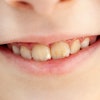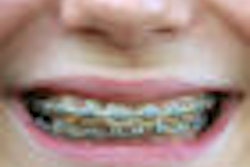Adding a small amount of fluorescent dye to orthodontic adhesive can make removing the adhesive that often remains after debonding much easier, according to a study in the European Journal of Orthodontics (September 16, 2010).
Orthodontic adhesive is often left on the tooth surface when a multibracket appliance is debonded and is difficult to remove because its color is similar to that of the tooth, researchers from Nihon University School of Dentistry noted. They posited that if the adhesive changed color during debonding, any residual could be more easily seen and removed.
The researchers bonded 64 metal brackets to flattened bovine enamel surfaces using adhesives with three concentrations of fluorescent dye (0.001%, 0.002%, and 0.003%) and determined the shear bond strength (SBS) and adhesive remnant index (ARI) scores for each adhesive. Color penetrating through the transparent bracket was measured using a color analyzer. SBS and fluorescence intensity were examined to determine the stability of the adhesives after they were subjected to a thermal cycle test (1,000 cycles).
The SBS of the adhesive with 0.003% fluorescent dye was significantly lower than that of the control (Transbond, 3M ESPE). In ARI tests, significantly more of the adhesive with 0.003% dye was left on the tooth surface after 24 hours compared with the other adhesives. With regard to color penetration, the adhesive with 0.003% dye was five times more visible than the others.
The researchers also found that SBS and fluorescence intensity of the adhesives were not affected by thermal cycling.
"An adhesive containing less than 0.002% fluorescent dye provides both sufficient bond strength for orthodontic brackets and sufficient fluorescent color for easy visualization without aesthetic impairment," they concluded.
Copyright © 2010 DrBicuspid.com



















